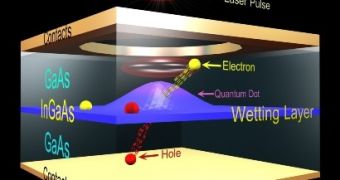Quantum physicist are growing ever more interested in pushing aside the current technology of making electronics, by experiments to better control the quantum spin, to create the fastest and most reliable electronics. The breakthrough in understanding how to make all the spins in an ensemble of quantum dots identical triggered the base to creating the new device for optics-based quantum computing and quantum information processing.
The research conducted at the University of Bochum, represents an important step towards the realization of such quantum devices based on the solid-state technology. A quantum bit of information can be stored in a quantum dot in which an electron spin is localized, and represents the basic unit for solid-state based quantum computing and information processing. The current digital computers use a binary language to process and store information, represented by a series of 0 and 1. An electron spin could work in the same classical way, by taking two values. The quantum spin represents a quantum object, meaning it can also take all the values in between the two states, enabling it to hold more information than the classical one, and multiplying exponentially the processing power of a computer, by using a superior numeration system.
Scientists around the world have been trying for years to replace the transistor, by other electronic components that could switch multiple states, rather that just two, but found that many where giving unreliable results after a few thousands switches, making the design of electronic devices with these components impossible. Now the physicists are trying to find more efficient ways of controlling and manipulating the spin of the electron in a quantum dot, through the use of electric and magnetic fields.
But there was one major problem of using charged quantum dots, in devices that used electron spins. They were never identical in different quantum dots. The electron spin precession frequencies differ from each other as a result of small variations in the quantum dot shape and size. The electron spin precession frequencies also contribute to a random hyperfine field of the nuclear spin in the quantum dot volume, making the coherent control and manipulation of the electron spin inside a quantum dot an impossibility, thus the researchers concentrated mostly on the manipulation of individual spins.
This was suggested as a result of demonstrating the method, by using periodic illumination with the help of a pulsed laser, to drive a large proportion of the electron spins in a ensemble of quantum dots into a synchronized motion. The team showed that almost the whole ensemble of the electron spins, about 90 percent, were processed coherently as a result of the resonant excitation. Through this process, the nuclear contribution works constructively by focusing the electron spin in different quantum dots. Modifications to the laser protocols will ensure that all the electron spins will have exactly the same precession frequency, to make all the spins inside the quantum dots identical.
The use of the technology to create the identical electron spins will focus on demonstrating all coherent q-bit single operations by using a ensemble of charged quantum dots, or to demonstrate the quantum-dot gate operation. This could also reveal certain details about the optical coherent phenomena, such as the electromagnetic transparency and the slow light.

 14 DAY TRIAL //
14 DAY TRIAL //